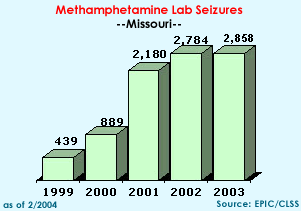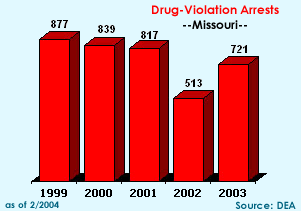 DEA
Offices & Telephone Nos. DEA
Offices & Telephone Nos.
Cape Girardeau—575-334-1534
Jefferson City—573-635-1331
Kansas City—913-825-4100
Springfield—417-831-3948
St. Louis—314-538-4600 |
State
Facts
Population: 5,629,707
Law Enforcement Officers: 14,793
State Prison Population: 38,400
Probation Population: 55,767
Violent Crime Rate
National Ranking: 15 |
2003
Federal Drug Seizures
Cocaine: 333.0 kgs.
Heroin: 5.3 kgs.
Methamphetamine: 11.4 kgs.
Marijuana: 4,827.3 kgs.
Ecstasy: 16,337
Methamphetamine Laboratories: 2,858 (DEA, state,
and local) |
Drug
Situation: Mexican poly-drug trafficking organizations control
a large majority of the distribution of methamphetamine, cocaine, marijuana,
and heroin in Missouri. Various organizations with ties to Texas and California
continue to traffic in cocaine and heroin. In addition, hundreds of small
toxic methamphetamine laboratories are found in all areas of Missouri.
 Cocaine: Enforcement
activities reflect a steady supply of cocaine coming into the metropolitan
areas of Missouri. The states of Texas and California
continue to be the major sources of supply. Crack cocaine continues to
be readily available in all urban areas of the state. After previous
declines, the number of cocaine-related overdose deaths continued to
rise in the St. Louis area during 2003. In addition, the number of
deaths resulting from cocaine in combination with other drugs continued
to increase. Cocaine: Enforcement
activities reflect a steady supply of cocaine coming into the metropolitan
areas of Missouri. The states of Texas and California
continue to be the major sources of supply. Crack cocaine continues to
be readily available in all urban areas of the state. After previous
declines, the number of cocaine-related overdose deaths continued to
rise in the St. Louis area during 2003. In addition, the number of
deaths resulting from cocaine in combination with other drugs continued
to increase.
 Heroin: The
trafficking and abuse of heroin in the St. Louis area is a significant
concern to law enforcement and to the community. Mexican black tar,
and to a lesser degree Mexican brown, Southwest Asian, and South American
heroin are all available in the St. Louis area. Heroin abuse appears
to have spread from the City of St. Louis to surrounding areas, as
evidenced by the continuing increase of heroin-related deaths in St.
Louis County. Mexican black tar and brown heroin are also available
on a limited basis in the Kansas City area. Heroin: The
trafficking and abuse of heroin in the St. Louis area is a significant
concern to law enforcement and to the community. Mexican black tar,
and to a lesser degree Mexican brown, Southwest Asian, and South American
heroin are all available in the St. Louis area. Heroin abuse appears
to have spread from the City of St. Louis to surrounding areas, as
evidenced by the continuing increase of heroin-related deaths in St.
Louis County. Mexican black tar and brown heroin are also available
on a limited basis in the Kansas City area.
  Methamphetamine: Both
Mexican and locally produced methamphetamine continue to be available
throughout the state. Generally, locally produced methamphetamine
is of higher potency than that imported from Mexico. The continuing proliferation
of small toxic laboratories throughout Missouri continues to put a
severe
strain on the resources of law enforcement. High purity crystal methamphetamine
or “ice” has become increasingly available in the Kansas
City area. Methamphetamine: Both
Mexican and locally produced methamphetamine continue to be available
throughout the state. Generally, locally produced methamphetamine
is of higher potency than that imported from Mexico. The continuing proliferation
of small toxic laboratories throughout Missouri continues to put a
severe
strain on the resources of law enforcement. High purity crystal methamphetamine
or “ice” has become increasingly available in the Kansas
City area.
 Predatory
Drugs: MDMA (Ecstasy) is available at dance clubs and colleges/universities
throughout the state. It is brought into the state from Los Angeles, New
York, and Miami. LSD is available in all parts of Missouri, but is not
seen as a significant problem. GHB and Rohypnol continue to be available. Predatory
Drugs: MDMA (Ecstasy) is available at dance clubs and colleges/universities
throughout the state. It is brought into the state from Los Angeles, New
York, and Miami. LSD is available in all parts of Missouri, but is not
seen as a significant problem. GHB and Rohypnol continue to be available.
 Marijuana:
Marijuana is readily available throughout the state with Mexican marijuana
being imported from the Southwest Border. Indoor marijuana growing
continues
to increase. "Grass roots" groups have promoted legalization,
but the state has not sanctioned the cause. Law enforcement agencies
do
not anticipate a shift in the official position. Treatment admissions
for marijuana use grew approximately 400 percent between 1994 and
2001, only exceeded by admissions for methamphetamine and amphetamine
abuse. Marijuana:
Marijuana is readily available throughout the state with Mexican marijuana
being imported from the Southwest Border. Indoor marijuana growing
continues
to increase. "Grass roots" groups have promoted legalization,
but the state has not sanctioned the cause. Law enforcement agencies
do
not anticipate a shift in the official position. Treatment admissions
for marijuana use grew approximately 400 percent between 1994 and
2001, only exceeded by admissions for methamphetamine and amphetamine
abuse.
 Other
Drugs: Oxycontin
abuse is increasing throughout the state. Vicodin, Percocet, and OxyContin
thefts are increasing as a result of window smashing of pharmacies in
the St. Charles area. These drugs are being used as an offset to heroin,
according to law enforcement reports. Other
Drugs: Oxycontin
abuse is increasing throughout the state. Vicodin, Percocet, and OxyContin
thefts are increasing as a result of window smashing of pharmacies in
the St. Charles area. These drugs are being used as an offset to heroin,
according to law enforcement reports.
 DEA
Mobile Enforcement Teams: This cooperative program with state
and local law enforcement counterparts was conceived in 1995 in response
to the overwhelming problem of drug-related violent crime in towns and
cities across the nation. There have been 409 deployments completed resulting
in 16,763 arrests of violent drug criminals as of February 2004. There
have been ten MET deployments in the State of Missouri since the inception
of the program: Sikeston, Fountain Park, St. Charles County, Audrain
County, Crystal City, Berkeley, Hannibal, Franklin County, Joplin, and
Springfield. DEA
Mobile Enforcement Teams: This cooperative program with state
and local law enforcement counterparts was conceived in 1995 in response
to the overwhelming problem of drug-related violent crime in towns and
cities across the nation. There have been 409 deployments completed resulting
in 16,763 arrests of violent drug criminals as of February 2004. There
have been ten MET deployments in the State of Missouri since the inception
of the program: Sikeston, Fountain Park, St. Charles County, Audrain
County, Crystal City, Berkeley, Hannibal, Franklin County, Joplin, and
Springfield.
DEA
Regional Enforcement Teams:
This program was designed to augment existing DEA division resources
by targeting drug organizations operating in the United States where
there is a lack of sufficient local drug law enforcement. This Program
was conceived in 1999 in response to the threat posed by drug trafficking
organizations that have established networks of cells to conduct drug
trafficking operations in smaller, non-traditional trafficking locations
in the United States. Nationwide, there have been 22 deployments completed
resulting in 608 arrests of drug trafficking criminals as of February
2004. There has been one RET deployment in the State of Missouri since
the inception of the program, in Springfield/Joplin.
Special
Topics:
The St. Louis Homicide Initiative was created by DEA St. Louis and the
St. Louis Metropolitan Police Department to address and combat the city's
increase in drug related homicides. The objectives of this initiative
are to identify violent organizations involved in drug trafficking activity
and to develop investigative leads by use of court authorized telephone
intercepts to clear unsolved homicides and related crimes. Missouri is
crossed by a number of Interstate Highways (Interstates 44, 64, and 70
from east to west; 35 and 55 from north to south), providing excellent
smuggling routes for drug trafficking organizations. During FY2003, highway
interdictions in Missouri led to seizures including approximately 380
kilograms of cocaine, 2.5 kilograms of heroin, 11.5 pounds of methamphetamine,
19,000 pounds of marijuana and nearly $1.8 million dollars.
More information
about the St. Louis Division Office.
Sources
Factsheet
last updated: 2/2004
Click
here for last year's 2003 factsheet>> |

